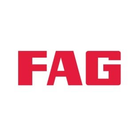

| Item # | d | D | B | r | Static Load Rating | Dynamic Load Rating |
| 2316 | 3.1496 in 80.000 mm |
6.6929 in 170.000 mm |
2.2835 in 58.000 mm |
0.0827 in 2.100 mm |
10100 lbf 45000 N 45.00 kN |
29200 lbf 130000 N 130.00 kN |
1. Design features and characteristics
The outer ring raceway of self-aligning ball bearings forms a spherical surface whose center is common to the bearing center. The inner ring of the bearing has two raceways.
The balls, cage, and inner ring of these bearings are capable of shifting in order to compensate for a certain degree of misalignment with the outer rings. As a result, the bearing is able to align itself and compensate for shaft / housing finishing unevenness, bearing fitting error, and other sources of misalignment as shown in Fig. 1.
Since axial load capacity is limited, self- aligning ball bearing are not suitable for applications with heavy axial loads.
It is recommended to use an adapter on a self-aligning ball bearing with a tapered bore inner diameter for ease of installation and disassembly. These bearings and adapters are often used on drive shaft applications.

2. Standard cage type
All bearing series are equipped with a pressed cage, except 2321S and 2322S, which are equipped with a machined cage.
Self-Aligning Ball Bearings
It is recommended to use an adapter on a self-aligning ball bearing with a tapered bore inner diameter for ease of installation and disassembly. These bearings and adapters are often used on drive shaft applications.
Table 1 Standard cage types of spherical ball bearings

3. Ball protrusion
Bearings with part numbers listed in Table 2 below have balls which protrude slightly from the bearing face as illustrated in Fig. 2. The total width dimensions are shown in Table 2.

4. Allowable misalignment angle
The allowable misalignment angle can be determined by the following function. This degree of allowable misalignment may be limited by the design of mating components around the bearing.
Normal load ....................... 1/15
5. Precautions for using self-aligning ball bearings
Self-aligning ball bearings are unable to support large axial loads and therefore axial loading shall be limited.
Please consider using self-aligning roller bearings when a large axial load is to be applied.






